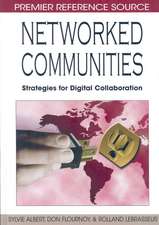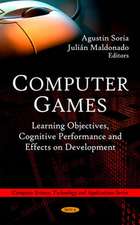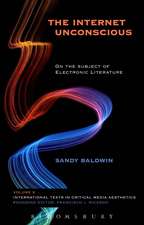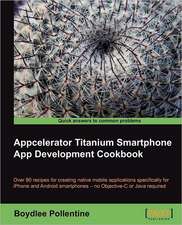Regards Croises: Perspectives on Digital Literature
Editat de PHILIPPE BOOTZ, Sandy Baldwinen Limba Engleză Paperback – 30 noi 2010
What happens to literature in an age of digital technology? Regards Croisés: Perspectives on Digital Literature provides an answer, with a collection of cutting-edge critical essays on literature gone digital. Regards Croisés is an important addition to existing research on digital literature, and will appeal to scholars of electronic writing, digital art,humanities computing, media and communication, and others interested in the field. It offers a significant advance in the field through its wide-angle perspective that globalizes digital literature and diversifies the current critical paradigms. Regards Croisés shows how digital literature connects with traditions and future directions of reading and writing communities all over the world. With contributions by authors from eight countries and three continents, the collection presents points of view on a transcontinental practice of digital literature. Regards Croisés also opens dialogues with expanded critical paradigms of digital literature, beyond earlier critical concern with the aesthetics of the screen as a space of hypertext links. Many of the essays recognize a rich history and ongoing literary practice engaged with the basic fact of the computer as a programmable device. Other essays explore the latest developments in social media and Web 2.0 as venues for digital literature. Regards Croisés shows the vibrant engagement of writers and readers with literary practice in a digital world.
Preț: 94.59 lei
Preț vechi: 118.24 lei
-20% Nou
Puncte Express: 142
Preț estimativ în valută:
18.10€ • 19.66$ • 15.21£
18.10€ • 19.66$ • 15.21£
Carte disponibilă
Livrare economică 01-15 aprilie
Preluare comenzi: 021 569.72.76
Specificații
ISBN-13: 9781933202471
ISBN-10: 1933202475
Pagini: 160
Ilustrații: 9
Dimensiuni: 140 x 216 x 15 mm
Greutate: 0.22 kg
Ediția:1st Edition
Editura: West Virginia University Press
Colecția West Virginia University Press
ISBN-10: 1933202475
Pagini: 160
Ilustrații: 9
Dimensiuni: 140 x 216 x 15 mm
Greutate: 0.22 kg
Ediția:1st Edition
Editura: West Virginia University Press
Colecția West Virginia University Press
Recenzii
“The contents of this book are fantastic.”
Chris Funkhouser, New Jersey Institute of Technology
“The essays in this book manage to offer . . . a refreshingly multifaceted approach.”
Jan Baetens, Leonardo
Chris Funkhouser, New Jersey Institute of Technology
“The essays in this book manage to offer . . . a refreshingly multifaceted approach.”
Jan Baetens, Leonardo
Notă biografică
Philippe Bootz is Assistant Professor of Hypermedia and Multimedia at the University of Paris 8. Bootz holds PhDs in Physics and Sciences of Information and Communication and is the cofounder of L.A.I.R.E, a French collective in digital literature and Transitoire Observable, an international collective in programmed poetry.
Sandy Baldwin is Associate Professor of English and Director of the Center for Literary Computing at West Virginia University. He received his PhD from New York University and is a Fulbright Scholar. His work imagines the future of literary studies in a digital age. As coordinator of the Center for Literary Computing at West Virginia University, he facilitates interdisciplinary research projects in the poetics of new media and the media ecology of literary institutions, using web-technologies, multimedia, hypertext, audio/video, and virtual environments. He publishes on the poetics and philosophy of digital writing and his solo and collaborative creative work is widely published and performed.
Sandy Baldwin is Associate Professor of English and Director of the Center for Literary Computing at West Virginia University. He received his PhD from New York University and is a Fulbright Scholar. His work imagines the future of literary studies in a digital age. As coordinator of the Center for Literary Computing at West Virginia University, he facilitates interdisciplinary research projects in the poetics of new media and the media ecology of literary institutions, using web-technologies, multimedia, hypertext, audio/video, and virtual environments. He publishes on the poetics and philosophy of digital writing and his solo and collaborative creative work is widely published and performed.
Textul de pe ultima copertă
What happens to literature in an age of digital technology? Regards Croisés: Perspectives on Digital Literature provides an answer, with a collection of cutting-edge critical essays on literature gone digital. Regards Croisés is an important addition to existing research on digital literature, and will appeal to scholars of electronic writing, digital art,humanities computing, media and communication, and others interested in the field. It offers a significant advance in the field through its wide-angle perspective that globalizes digital literature and diversifies the current critical paradigms. Regards Croisés shows how digital literature connects with traditions and future directions of reading and writing communities all over the world. With contributions by authors from eight countries and three continents, the collection presents points of view on a transcontinental practice of digital literature. Regards Croisés also opens dialogues with expanded critical paradigms of digital literature, beyond earlier critical concern with the aesthetics of the screen as a space of hypertext links. Many of the essays recognize a rich history and ongoing literary practice engaged with the basic fact of the computer as a programmable device. Other essays explore the latest developments in social media and Web 2.0 as venues for digital literature. Regards Croisés shows the vibrant engagement of writers and readers with literary practice in a digital world.
Cuprins
•Preface, Sandy Baldwin
•Editorial, Phillippe Bootz
•Narrative Motors, Eugenio Tisselli •1 The metaphor of narrative motors
•2 Exercises in style with executable languages
•3 Combinatory Language Practices
•4 Process-driven narrations
•5 Metadata in motion
The Unsatisfied Reading, Philippe Bootz •1 Introduction
•2 The theses of Walter Benjamin and Mario Costa •2.1 Shared concepts of “distant, however close it may be”
3 Presentation as a modality of representation •3.1 The private-reading procedural system operates through displacement
•3.2 A seismic event of magnitude 3 on Costa scale
•3.3 The procedural work: a “being in itself” deprived of aseity
4 The artist’s condition •4.1 “I demonstrate concepts”
•4.2 The displaced work and the ritual work
5 The recursive loop between presentation and representation •5.1 Presentation differs from representation
•5.2 The dialectics of presentation and representation
•5.3 The splitting of reading
6 Conclusion: the reader as “en-jeu” “Agents provocateurs”: Codework Interventions on the Listservs, Camille Paloque-Berges •1 Introduction: a poetics of information?
•2 Agonistic noise experimentation with listserv protocols
•3 Is text-code a critical reproduction or a speculative reprogramming of discourses?
•4 Observation and tattling in textual situations
•5 Protocols of public community: informatic and semiotic codes
Speak, “Memory”: Simulation and Satire in Reagan Library, Shuen-shing Lee •1 Introduction
•2 Speak, “Memory”
•3 Notes on the Final Construct
•4 The Mnemonic Simulation
•5 A Surrealistic Satire
•6 “There is no flow chart”
Digital Poetry Beyond the Metaphysics of “Projective Saying,” Janez Strehovec •1 Introduction
•2 Mutations in Poetry
•3 Cybertextuality Attitude
•4 Multimedia shaped text
•5 Thanks for watching (a poem)
How to Read Words in Digital Literature, Alckmar Luiz dos Santos •1 Introduction
•2 An example
•3 Toward a rhetoric of brevity
Textual Material in the Digital Medium, Alexandra Saemmer •1 Introduction
•2 Reflexive, immersive, contemplative readings
•3 A new semantic proximity between words and images
•4 Animated calligrammes
•5 Limits of the calligramme
•6 Toward the opening of the semantic and graphic potential of the text
•7 The metonymic action of hyperlinks
•8 Metaleptic effects
•9 Animated hypotyposes
•10 Metaphorical animations
Figures •Figure 1: Listserv posting by Netochka Nezvanova, 2006.
•Figure 2: Listserv posting by JODI, 1998.
•Figure 3: Screen shot from Stuart Moulthrop’s Reagan Library, 1999.
•Figure 4: Screen shot from Stuart Moulthrop’s Reagan Library, 1999.
•Figure 5: Screen shot from Stuart Moulthrop’s Reagan Library, 1999.
•Figure 6: Screen shot from Stuart Moulthrop’s Reagan Library, 1999.
•Figure 7: Screen shot from Stuart Moulthrop’s Reagan Library, 1999.
•Figure 8: Screen shot from Stuart Moulthrop’s Reagan Library, 1999.
•Figure 9: Screenshot from Claire Dinsmore’s The Dazzle as Question, 2000
•Editorial, Phillippe Bootz
•Narrative Motors, Eugenio Tisselli •1 The metaphor of narrative motors
•2 Exercises in style with executable languages
•3 Combinatory Language Practices
•4 Process-driven narrations
•5 Metadata in motion
The Unsatisfied Reading, Philippe Bootz •1 Introduction
•2 The theses of Walter Benjamin and Mario Costa •2.1 Shared concepts of “distant, however close it may be”
3 Presentation as a modality of representation •3.1 The private-reading procedural system operates through displacement
•3.2 A seismic event of magnitude 3 on Costa scale
•3.3 The procedural work: a “being in itself” deprived of aseity
4 The artist’s condition •4.1 “I demonstrate concepts”
•4.2 The displaced work and the ritual work
5 The recursive loop between presentation and representation •5.1 Presentation differs from representation
•5.2 The dialectics of presentation and representation
•5.3 The splitting of reading
6 Conclusion: the reader as “en-jeu” “Agents provocateurs”: Codework Interventions on the Listservs, Camille Paloque-Berges •1 Introduction: a poetics of information?
•2 Agonistic noise experimentation with listserv protocols
•3 Is text-code a critical reproduction or a speculative reprogramming of discourses?
•4 Observation and tattling in textual situations
•5 Protocols of public community: informatic and semiotic codes
Speak, “Memory”: Simulation and Satire in Reagan Library, Shuen-shing Lee •1 Introduction
•2 Speak, “Memory”
•3 Notes on the Final Construct
•4 The Mnemonic Simulation
•5 A Surrealistic Satire
•6 “There is no flow chart”
Digital Poetry Beyond the Metaphysics of “Projective Saying,” Janez Strehovec •1 Introduction
•2 Mutations in Poetry
•3 Cybertextuality Attitude
•4 Multimedia shaped text
•5 Thanks for watching (a poem)
How to Read Words in Digital Literature, Alckmar Luiz dos Santos •1 Introduction
•2 An example
•3 Toward a rhetoric of brevity
Textual Material in the Digital Medium, Alexandra Saemmer •1 Introduction
•2 Reflexive, immersive, contemplative readings
•3 A new semantic proximity between words and images
•4 Animated calligrammes
•5 Limits of the calligramme
•6 Toward the opening of the semantic and graphic potential of the text
•7 The metonymic action of hyperlinks
•8 Metaleptic effects
•9 Animated hypotyposes
•10 Metaphorical animations
Figures •Figure 1: Listserv posting by Netochka Nezvanova, 2006.
•Figure 2: Listserv posting by JODI, 1998.
•Figure 3: Screen shot from Stuart Moulthrop’s Reagan Library, 1999.
•Figure 4: Screen shot from Stuart Moulthrop’s Reagan Library, 1999.
•Figure 5: Screen shot from Stuart Moulthrop’s Reagan Library, 1999.
•Figure 6: Screen shot from Stuart Moulthrop’s Reagan Library, 1999.
•Figure 7: Screen shot from Stuart Moulthrop’s Reagan Library, 1999.
•Figure 8: Screen shot from Stuart Moulthrop’s Reagan Library, 1999.
•Figure 9: Screenshot from Claire Dinsmore’s The Dazzle as Question, 2000
















